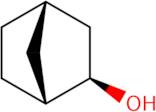Exo-norborneol
CAS: 497-37-0
Ref. 3D-AAA49737
| 2g | Descontinuado | ||
| 5g | Descontinuado | ||
| 10g | Descontinuado | ||
| 25g | Descontinuado | ||
| 50g | Descontinuado | ||
| 100g | Descontinuado | ||
| 250g | Descontinuado | ||
| 500g | Descontinuado |
Informação sobre produto
- (1R,2R,4S)-bicyclo[2.2.1]heptan-2-ol
- (1S,2S,4R)-bicyclo[2.2.1]heptan-2-ol
- (2S,4R)-bicyclo[2.2.1]heptan-2-amine
- 2-Norbornanol, exo-
- 2-exo-Norbornanol
- 2-exo-Norborneol
- Bicyclo[2.2.1]heptan-2-ol, (1R,2R,4S)-rel-
- Bicyclo[2.2.1]heptan-2-ol, exo-
- NSC 167460
- d,l-exo-Norborneol
- Ver mais sinónimos
- exo-(±)-2-Norborneol
- exo-2-Bicyclo[2.2.1]heptanol
- exo-2-Hydroxybicyclo[2.2.1]heptane
- exo-2-Norbornanol
- exo-2-Norbornyl alcohol
- exo-Bicyclo[2.2.1]heptan-2-ol
- exo-Norbornanol
- exo-Norbornyl alcohol
- rel-(1R,2R,4S)-Bicyclo[2.2.1]heptan-2-ol
- exo-Norborneol
Norborneol is an organic chemical compound that is derived from the reduction of norbornene with a strong reducing agent. It has a hydroxyl group on the terminal carbon and a steric interaction with the adjacent hydrocarbon. Exo-norborneol can be synthesized by reacting an alcohol, such as methanol, with an acid chloride, such as trifluoroacetic acid. The reaction solution must be neutralized before it is heated to drive off the water produced in the reaction. Norbornene can also be reduced by hydrogen gas and palladium on charcoal to produce exo-norborneol. A catalyst is needed for this reaction because of the high kinetic energy of hydrogen gas.





